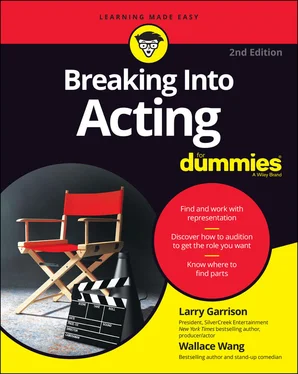 Just because a studio either options or purchases the rights to a script doesn’t necessarily mean that the script will ever get produced. Many screenplays for films circulate various studios for years before someone finally makes it into a film.
Just because a studio either options or purchases the rights to a script doesn’t necessarily mean that the script will ever get produced. Many screenplays for films circulate various studios for years before someone finally makes it into a film.
After a production company or studio buys the rights to a story idea, the next step is to produce the script, which is the responsibility of the producer. (Many producers run their own production companies and work with studios, but if a studio has an idea that they want produced, they may hire the producer who optioned the rights to the project.)
Producing a script involves several packaging processes:
Hiring a director: The producer hires the director. The director and the producer, and sometimes with a studio, may then work together to hire the rest of the production crew, such as a costume designer or choreographer.
Polishing the script: Scriptwriters often rewrite the script several times, sometimes for valid reasons to strengthen the story and sometimes for trivial reasons, such as to accommodate a major star who wants a certain role expanded or altered before she will agree to play the role.
Scouting out locations to film scenes: The producer, along with several assistants, may scout locations for filming.
Finding and booking a place to rehearse: The director, an assistant, or the stage manager takes care of setting a rehearsal schedule. In film and television, rehearsals take place on the set. In theater, rehearsals may take place anywhere, usually because the actual set or theater isn’t available yet.
Setting a shooting or rehearsal schedule: In film and television, the director and producer may collaborate on defining a shooting schedule. In theater, the director and stage manager may set a rehearsal schedule.
Establishing a budget: The producer is responsible for estimating the cost of producing the film, television show, or play. (A producer may also hire a unit production manager to help with this task as well.) She must consider the cost of the shooting locations, actors’ salaries, costumes, catering, travel and lodging expenses, special effects (a fire or a snow storm, for example), and so on. Budgets are often divided into above-line and below-line costs. Above-line costs make up the expenses for the creative people including the major actors, director, and producer. The below-line costs are for the technical people needed, such as lighting technicians, makeup artists, and costume designers.
Storyboarding each scene: For a film, an artist sketches out the way each scene will look, a process known as storyboarding. By seeing a sketch of a scene, a director can tell whether filming a scene from a specific angle will work. Finding and fixing problems on a storyboard is infinitely faster and less expensive than trying to fix the problem during filming or after the film has already been shot.
Auditioning actors to play the various roles: Every speaking role, from the major starring roles to the smallest roles where the actor may just say one line, must be filled.
STRETCHIN’ THAT PRODUCTION DOLLAR
Because a production’s budget only goes so far, the director and producer always look for ways to cut costs without sacrificing quality. One such way is to cut corners on the set. For example, instead of building an entire log cabin, they may just build a front façade and cleverly mask the sides with additional scenery or film from certain angles, so that no one will notice that three walls are missing. Not only do they save money this way, but they also save time in construction.
Another common cost-cutting method is shooting films out of sequence. If the beginning and end of a film take place in the same location, such as in Singapore or on the deck of a cruise ship, the director films all those scenes at the same time before moving to a new location and a new group of scenes. That way the entire film crew doesn’t have to visit the same location twice (and avoid additional traveling expenses) just to film two different scenes in chronological order.
After the script has been developed, the project is considered green lit when it moves into production. Production involves building sets and designing costumes. Also during the production phase, actors are measured and fitted for costumes, introduced to their fellow actors, and put through rehearsals to learn their lines and practice their movements on the stage or in front of the camera.
As an actor, one of the most important aspects of going to production is the beginning of rehearsals. In general, rehearsals go through three phases:
A dry rehearsal: This first phase is designed to acquaint the actors with their roles and their lines. Dry rehearsals may take place at a table where all the actors read the script while making any suggestions or changes. Some rehearsals are even done through video conferencing apps.
The walk-through: After the actors are familiar with their lines, they get acquainted with their positions on the stage or set. During this time, actors usually rehearse in their street clothes and may or may not be on the actual set where they will actually perform. The purpose of the walk-through is to discover any logistical problems, such as finding that some actors don’t have enough time to exit off the stage and change into a different costume before their appearance in the next scene. When this second phase of rehearsals begins, actors practice the required movements in a given scene by blocking their actions. This preliminary step allows actors to avoid any awkward positions, such as one actor walking in front of another actor or standing with her back to the camera (unless, of course, that’s the image that the director wants).
The dress rehearsal: During this final phase, actors rehearse on the actual set while wearing the costumes that they’ll wear during the show. The actors and director have a chance to spot any additional problems with costumes and set design, such as doors that don’t open properly, dresses that prohibit certain movements among the set because of their bulk, or lights that cast shadows across an actor’s face. On a film set, actors who look and dress similar to the stars act as stand-ins for the stars, so the camera crew can adjust and focus their cameras before the real stars show up. Note: In stage plays, actors rehearse much longer and more often than they would do for a film, television show, or commercial. In film and TV, actors may be lucky to get even one rehearsal before the cameras start rolling, so it’s a good idea to have your lines and movements ready before you show up on the set that day.
The time for rehearsals always runs out too quickly before showtime. That’s when the actors perform for real in front of a live audience or in front of the camera.
 Showtime is the pinnacle of all that the cast and crew have worked for. So as an actor, you must try especially hard at this stage to behave professionally, which means showing up on time, being prepared, and doing your job to your best ability. If you do anything that threatens to disrupt a show, you can always be fired at any time.
Showtime is the pinnacle of all that the cast and crew have worked for. So as an actor, you must try especially hard at this stage to behave professionally, which means showing up on time, being prepared, and doing your job to your best ability. If you do anything that threatens to disrupt a show, you can always be fired at any time.
Sometimes, the best stage actors never make the transition to film and television, while film and television actors may not do as well on the stage as they do in front of the camera. The reason is because film, television, and theater all require different types of acting skills for performing in different environments. With film, you have time to prepare, but television goes much faster. I (Larry) personally was filming a TV series segment with Mark Harmon. Coming from a background with Lee Strasberg, I was using his technique of emotional memory. The producer came up to me and said, “What are you doing?” I responded, “I’m preparing an emotional memory.” He looked at me, laughed, and said, “Throw that away and just say the words.” Ten years of preparation for this moment, and I just said the words.
Читать дальше

 Just because a studio either options or purchases the rights to a script doesn’t necessarily mean that the script will ever get produced. Many screenplays for films circulate various studios for years before someone finally makes it into a film.
Just because a studio either options or purchases the rights to a script doesn’t necessarily mean that the script will ever get produced. Many screenplays for films circulate various studios for years before someone finally makes it into a film.










